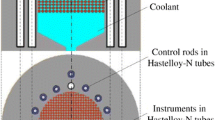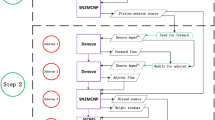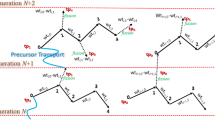Abstract
The 10 MWth solid-fueled thorium molten salt reactor (TMSR-SF1) is a FLiBe salt-cooled pebble bed reactor to be deployed in 5–10 years, designed by the TMSR group. Due to a large amount of beryllium in the core, the photoneutrons are produced via (γ, n) reactions. Some of them are generated a long time after the fission event and therefore are considered as delayed neutrons. In this paper, we redefine the effective delayed neutrons into two fractions: the delayed fission neutron fraction and the delayed photoneutron fraction. With some reasonable assumptions, the inner product method and the k-ratio method are adopted for studying the effective delayed photoneutron fraction. In the k-ratio method, the Monte Carlo code MCNP6 is used to evaluate the effective photoneutron fraction as the ratio between the multiplication factors with and without contribution of the delayed neutrons and photoneutrons. In the inner product method, with the Monte Carlo and deterministic codes together, we use the adjoint neutron flux as a weighting function for the neutrons and photoneutrons generated in the core. Results of the two methods agree well with each other, but the k-ratio method requires much more computing time for the same precision.





Similar content being viewed by others
References
T. Allen, S. Ball, E Blandford et al., in Preliminary fluoride salt-cooled high temperature reactor (FHR) subsystems definition, functional requirement definition and licensing basis event (LBE) identification white paper. University of California, Berkeley, UCBTH-12-001 (2012)
C. Forsberg, L.W. Hu, J. Richard et al., in Fluoride-salt-cooled high temperature test reactor (FHTR): goals, options, ownership, requirements, design, licensing, and support facilities. Massachusetts Institute of Technology, MIT-ANP-TR-154 (2014)
K. Sun, L.W. Hu, C. Forsberg, Neutronic design features of a transportable fluoride-salt-cooled high-temperature reactor. ASME J. Nucl. Radiat. Sci. 2, 031003-031003-10 (2016). doi:10.1115/1.4032873
M.H. Jiang, H.J. Xu, Z.M. Dai, Advanced fission energy program—TMSR nuclear energy system. Bull. Chin. Acad. Sci. 27, 366–374 (2012). doi:10.3969/j.issn.1000-3045.2012.03.016
TMSR group, in TMSR-SF1 conceptual design overview, chapter 2. Shanghai Institute of Applied Physics, Shanghai (2015)
M. Aufiero, M. Fratoni, in Development of multi-physics tools for fluoride-cooled high-temperature reactors. PHYSOR 2016, Sun Valley, 1–5 May 2016
C.E. Cohn, Errors in reactivity measurements due to photoneutrons effects. Nucl. Sci. Eng. 6, 284–287 (1959)
G. Hordósy, A. Keresztúri, P. Vértes et al., Influence of the photoneutrons on the kinetics of the beryllium reflected core of the budapest research reactor. In Advanced Monte Carlo for Radiation Physics, Particle Transport Simulation and Applications, Lisbon, 23–26 Oct 2000
S.S. Lomakin, YuA Nechaev, Transient processes and the measurement of reactivity of a reactor containing beryllium. Sov. At. Energy 18, 35–42 (1965). doi:10.1007/BF01116353
F.B. Buoni, in Experience with the use of the rod-drop method of rod calibration at the ORR and LITR. ORNL, ORNL-TM-605 (1963)
L.J. Meng, W. Lai, G.Q. Huang et al., Design and verification of a portable reactivity meter used for high temperature reactor. Nucl. Electron. Detect. Technol. 35, 917–920 (2015). doi:10.3969/j.issn.0258-0934.2015.09.017. (in Chinese)
R.M. Ji, M.H. Li, Y. Zou et al., Impact of photoneutrons on reactivity measurements for TMSR-SF1. Nucl. Sci. Tech. 28, 76 (2017). doi:10.1007/s41365-017-0234-7
M. Carta, S. Dulla, V. Peluso et al., Calculation of the effective delayed neutron fraction by deterministic and monte carlo methods. Sci. Technol. Nucl. Install. (2011). doi:10.1155/2011/584256. (Article ID 584256)
F. Jatuff, A. Lüthi, M. Murphy et al., Measurement and interpretation of delayed photoneutrons effects in multizone criticals with partial D2O moderation. Ann. Nucl. Energy 30, 1731–1755 (2003). doi:10.1016/S0306-4549(03)00136-1
M.S. Onegin, Delayed photoneutrons in the PIK reactor. At. Energy 107, 194–201 (2009). doi:10.1007/s10512-010-9215-1
B. Dionne, N. Hanan, Impact of photoneutrons on transients for the MURR and MITR HEU and LEU cores. In The 32nd RERTR 2010 International Meeting on Reduced Enrichment for Research and Test Reactors, Lisbon, 10–14 Oct 2010
M.M. Bretscher, Perturbation independent methods for calculating research reactor kinetic parameters, Argonne National Laboratory, ANL/RERTR/TM30 (1997)
Z. Zhong, A. Talamo, Y. Gohar, Monte Carlo and deterministic computational methods for the calculation of the effective delayed neutron fraction. Comput. Phys. Commun. 184, 1660–1665 (2013). doi:10.1016/j.cpc.2013.02.009
V. Bécares, S. Pérez-Martín, M. Vázquez-Antolín et al., Review and comparison of effective delayed neutron fraction calculation methods with Monte Carlo codes. Ann. Nucl. Energy 65, 402–410 (2014). doi:10.1016/j.anucene.2013.11.038
M. Arkani, M. Hassanzadeh, S. Khakshournia, Calculation of six-group importance weighted delayed neutron fractions and prompt neutron lifetime of MTR research reactors based on Monte Carlo method. Prog. Nucl. Energy 88, 352–363 (2016). doi:10.1016/j.pnucene.2015.12.005
S.A. Hosseinia, M. Athari Allafb, Benchmarking of the HTR-10 reactor’s kinetic parameters: effective delayed neutron fraction. Prog. Nucl. Energy 75, 80–91 (2014). doi:10.1016/j.pnucene.2014.04.015
D. B. Pelowitz (ed.), MCNP6TM User’s Manual, Los Alamos National Laboratory, LA-CP-13-00634 (2013)
T.B. Fowler, D.R. Vondy, G.W. Cummingham, Nuclear reactor analysis code: CITATION. ORNL, USA, ORNL-TM-2496 (1969)
K. Tsuchihashi, H. Takano, K. Horikami et al., SRAC2006: a comprehensive neutronics calculation code system. JAEA, Japan, JAEA-Data/Code 2007-004 (2007)
F. Shen, Z. Lu, Z.Y. Sun et al., Delayed photon-induced neutron parameters on reactor of in-hospital neutron irradiator for boron neutron capture therapy. At. Energy Sci. Technol. 42, 697–701 (2008). (in Chinese)
Author information
Authors and Affiliations
Corresponding authors
Additional information
This work was supported by the Chinese TMSR Strategic Pioneer Science and Technology Project (No. XDA02010000).
Rights and permissions
About this article
Cite this article
Ji, RM., Dai, Y., Zhu, GF. et al. Evaluation of the fraction of delayed photoneutrons for TMSR-SF1. NUCL SCI TECH 28, 135 (2017). https://doi.org/10.1007/s41365-017-0285-9
Received:
Revised:
Accepted:
Published:
DOI: https://doi.org/10.1007/s41365-017-0285-9




